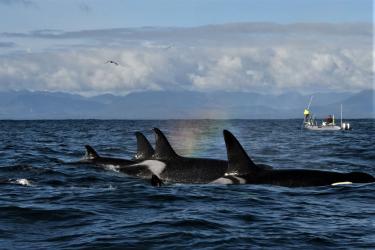Coral reefs are the most diverse habitats on the planet. They are homes for fish, crabs, seahorses, sea turtles, and more. They provide coastal protection for communities and millions of dollars in recreation and tourism. There are both shallow coral reef habitats and deep-sea coral habitats.
Despite their great economic and recreational value, corals are severely threatened by rapidly worsening environmental conditions (such as ocean acidification and rising water temperature).They are also threatened by human activity, such as pollution, oil and chemical spills, ship groundings, and marine debris. Corals are slow growing. When they are harmed, it can take many decades—even centuries—for them to recover.
The best way to conserve coral reefs and reduce future habitat loss is to know everything we can about them. Explore the features below to learn about coral species, coral reef habitats, and the work NOAA Fisheries does to research and protect this diverse group of animals.
Coral Features
Hawai‘i Coral Reef Assessments Complete for 2024
Kānaka ʻŌiwi knowledge systems, values, and practices inform a 3-month mission assessing coral reef health and ocean conditions in Hawai‘i as part of the National Coral Reef Monitoring Program.
Learn about the effort to effort to collect long-term data on coral reef communities of Hawai‘i
Special Journal Issue Compiles Advances in Coral Reef Ecosystem Science
New research dives to new depths to advance our knowledge on coral reef ecosystems in a special issue of Bulletin of Marine Science.
Learn about new coral reef research
Restoring Coral and Stream Banks Through the National Fish Habitat Partnership
Partners are making great strides in habitat restoration and angler engagement projects in Hawaiʻi and Alaska.
Learn about coral restoration through the National Fish Habitat Partnership
Under Pressure to Restore Deep-Sea Corals
NOAA Fisheries and partners conducted a saturation diving mission deep in the Gulf of Mexico to advance our coral restoration efforts. Throughout the mission, the pressure was on in more ways than one—literally and competitively.
Learn more about the diving mission to restore deep sea habitats
Emergency Restoration Protects Sea Turtles and Corals from a Drug Runner Semi-Submersible Grounded in Mona Island, Puerto Rico
NOAA collaborated with partners on emergency restoration actions on Mona Island, Puerto Rico to avoid irreversible loss of natural resources and to prevent any continuing danger to natural resources related pollution caused by a submersible drug runner.
Emergency restoration in Mona Island, Puerto Rico
Millionth Spiny Superhero Released to Devour Hawaiʻi's Coral-smothering Algae
NOAA and the Hawaii Division of Aquatic Resources’ have deployed 1 million sea urchins are part of our work restoring corals after the M/V Cape Flattery grounded on an Oʻahu reef.
Sea urchins help to restore struggling corals
New Hope for Puerto Rico’s Coral Reefs
With $10.6 million in new funding through NOAA, our long-time Puerto Rico partner Institute for Socio-Ecological Research is poised to restore coral reefs on a massive scale.
Learn more about this collaboration for coral restoration
Local Talent and Indigenous Knowledge Key to Restoring Hawaiʻi Coral Reefs
Threats to coral are increasing and the involvement of the local community is imperative. With funding through NOAA’s underserved community grants, Kuleana Coral Restoration graduated their first cohort of local and Native Hawaiian ocean conservationists.
Read more about Kuleana Coral Restoration
Deep-Sea Pioneers Take Root in the Gulf of Mexico
The first seafloor trials are under way to restore coral communities impacted by the Deepwater Horizon oil spill.
Learn more about the outplanting efforts
Mesophotic and Deep Benthic Communities Restoration
Vital seafloor habitats were damaged by the 2010 Deepwater Horizon oil spill. NOAA and partners are building a network of experts and resources to restore this underexplored area in the Gulf of Mexico.
Habitat restoration in the mesophotic zone and deep-sea communities
Restoring Coral Reefs
Coral reefs provide coastal protection for communities, habitat for fish, and millions of dollars in recreation and tourism, among other benefits. But corals are also severely threatened by rapidly worsening environmental conditions. Learn how NOAA works to restore these valuable habitats.
Learn about NOAA's coral reef restoration work
Meet Your Pacific Islands Protected Coral Species
Five of the 15 Indo-Pacific corals listed as threatened under the Endangered Species Act occur in U.S. waters. Get to know them!
Meet the Pacific Islands protected coral species
How Are Fisheries and Coral Reefs Connected?
Learn how overfishing impacts corals and what you can do to protect these important ecosystems.
More on the connected between fisheries and coral reefs
Multimedia
Video: Community Members Restore Hawaiʻi Coral Reefs and Reconnect with Traditional Hawaiian Ecological Practices
With support from NOAA, Kuleana Coral Restoration is training Native Hawaiians and community members in coral reef restoration. Meet the people taking part in the program.
Meet the community members participating in Kuleana’s COAST program
Podcast: Restoring Florida's Iconic Coral Reefs
Mission: Iconic Reefs is an effort to protect and restore seven key reef sites in the Florida Keys National Marine Sanctuary.
Listen to a podcast about coral reef restoration in Florida
Story Map: Explore Mesophotic and Deep Benthic Communities Expeditions in the Gulf of Mexico
Learn about expeditions informing restoration of habitats injured in the Deepwater Horizon oil spill

















